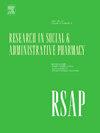Insights into community pharmacists’ behavioural intention towards providing safe medication disposal service using the theory of planned behaviour
IF 2.8
3区 医学
Q1 PUBLIC, ENVIRONMENTAL & OCCUPATIONAL HEALTH
Research in Social & Administrative Pharmacy
Pub Date : 2025-07-05
DOI:10.1016/j.sapharm.2025.06.111
引用次数: 0
Abstract
Background
Household pharmaceutical waste disposal in Malaysia is inadequate, largely due to limited awareness and a lack of safe disposal facilities. Community pharmacies are not legally required to collect unused or expired medications and face various challenges in offering disposal services. Therefore, it is essential to investigate the factors influencing community pharmacists’ intention to provide safe medication disposal.
Objectives
This study aims to identify the attitude, subjective norm and perceived behavioural control affecting Malaysian community pharmacists’ intention to provide medication take-back service and to identify the predictors of this intention.
Methods
A cross-sectional survey was conducted with a stratified random sample of 424 community pharmacists in the Klang Valley. The Theory of Planned Behaviour (TPB) served as the theoretical framework, with constructs measured using a 4-point Likert scale. Partial Least Squares Structural Equation Modeling (PLS-SEM) was used to analyse how TPB constructs and external factors influence pharmacists' intention.
Results
Of the 424 surveys, 310 responses were received (response rate: 73.1 %). The PLS-SEM model explained 66 % of the variance in pharmacists' intention (R2 = 0.662, adjusted R2 = 0.656). While attitude was not a significant predictor, subjective norm e.g. patient demand and external factors e.g. business competitiveness were significant positive predictors. Conversely, perceived behavioural control factors, including workload, costs, space and authority negatively impacted intention.
Conclusions
This study identifies key constructs influencing community pharmacists' intention to offer medication take-back service. A multifaceted approach involving clear regulatory frameworks, government support and pharmaceutical industry participation, and public education is necessary to enhance this intention.
利用计划行为理论研究社区药师提供安全药物处置服务的行为意向。
背景:马来西亚的家庭医药废物处理不足,主要是由于意识有限和缺乏安全的处置设施。法律没有要求社区药房收集未使用或过期的药物,在提供处置服务方面面临各种挑战。因此,有必要对影响社区药师提供安全处置药物意愿的因素进行研究。目的:本研究旨在找出影响马来西亚社区药剂师提供药物回收服务意愿的态度、主观规范和感知行为控制,并找出该意愿的预测因子。方法:对巴生谷424名社区药师进行分层随机抽样横断面调查。计划行为理论(TPB)作为理论框架,使用4点李克特量表测量结构。采用偏最小二乘结构方程模型(PLS-SEM)分析TPB结构和外部因素对药师意向的影响。结果:在424份问卷中,共收到310份回复,回复率为73.1%。PLS-SEM模型解释了66%的药师意向方差(R2 = 0.662,调整后R2 = 0.656)。虽然态度不是显著的预测因子,但主观规范(如病人需求)和外部因素(如商业竞争力)是显著的正向预测因子。相反,感知到的行为控制因素,包括工作量、成本、空间和权威,对意愿产生负面影响。结论:本研究确定了影响社区药师提供药物回收服务意愿的关键因素。需要采取多方面的办法,包括明确的管理框架、政府支持和制药业参与以及公众教育,以加强这一意图。
本文章由计算机程序翻译,如有差异,请以英文原文为准。
求助全文
约1分钟内获得全文
求助全文
来源期刊

Research in Social & Administrative Pharmacy
PUBLIC, ENVIRONMENTAL & OCCUPATIONAL HEALTH-
CiteScore
7.20
自引率
10.30%
发文量
225
审稿时长
47 days
期刊介绍:
Research in Social and Administrative Pharmacy (RSAP) is a quarterly publication featuring original scientific reports and comprehensive review articles in the social and administrative pharmaceutical sciences. Topics of interest include outcomes evaluation of products, programs, or services; pharmacoepidemiology; medication adherence; direct-to-consumer advertising of prescription medications; disease state management; health systems reform; drug marketing; medication distribution systems such as e-prescribing; web-based pharmaceutical/medical services; drug commerce and re-importation; and health professions workforce issues.
 求助内容:
求助内容: 应助结果提醒方式:
应助结果提醒方式:


